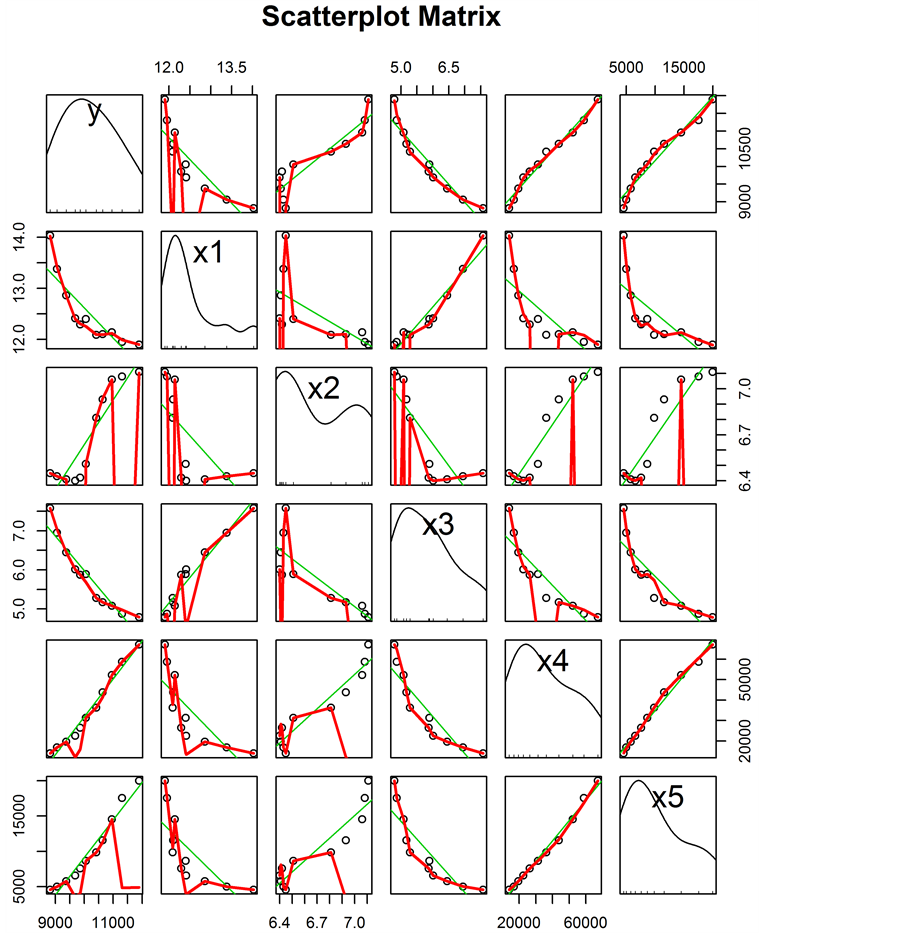1. 引言
我国人口一直保持世界人口较大比例。我国人口老龄化提前达到高峰。在20世纪后期,我国为了控制人口的快速增长,制定了计划生育政策,通过推行计划生育政策,使得我国人口出生率在迅速下降,从而加快了我国人口老龄化的进程。由于在21世纪前期,我国人口压力仍然沉重,因此还要继续坚持计划生育的政策,其结果将不可避免地使中国提早达到人口老龄化高峰。先期进入老龄化社会的一些发达国家,其人均GDP达到20000美元以上,呈现出“先富后老”,这为解决人口老龄化带来的问题奠定了经济基础。而中国进入老龄化社会时,人均GDP约为3000美元,呈现出“未富先老”,由于经济实力还不强,无疑增加了解决老龄化问题的难度。在21世纪前期,我国在建立和完善社会主义市场经济体制过程中,改革和发展的任务繁重,经济和社会要可持续发展,社会要保持稳定,各种矛盾错综复杂,使得解决人口老龄化问题相对发达国家和人口少的国家更为艰巨。我国进入老龄化社会以来,呈现出老年人口基数大、增速快、高龄化、失能化、空巢化趋势明显的态势,再加上我国未富先老的国情和家庭小型化的结构叠加在一起,养老问题异常严峻。如何能够准确的预测我国未来几年老龄化人口,这对我国应对相应的问题是有帮助,可以我国制定一些政策提供理论依据。因此对我国老龄化人口预测是有非常重要的实际意义。
国外有许多的学者对人口老龄化的预测模型的研究,国外研究是从John Graunt对人口预测模型的研究开始,其中他发布的关于人口预测的文章《死亡表的观察》比较著名,他在死亡表当中引进了一种新的比率,那就是死亡率,据此对以后人口的演变趋势进行预测。从而开创了人口预测的先河。随后日本的Ueda Masco以及瑞典的Grstav Sundbarg [1] 等人口学家在1898年都对人口老龄化问题做了进一步的研究,找出社会经济发展与人口老龄化之间的关系,从而做了更深入的研究。Grstav Sundbarg在研究人口预测的时候提出了一个新的假设条件:世界人口的生育率水平首先会随着时间的推移下降至更替水平,然后维持在这个水平长期保持不变。在2007年,Jakub Bijak [2] 提出采用三种迁移方案对所选27个国家2002年至2052年的人口及劳动力情况进行预测,得到人口迁移达不到将人口老龄化给经济发展带来的负面影响抵消的结果。在1991年,David E.Wildsin [3] 指出人口老龄化不仅使得享有社会保障的就业人员的边际福利成本提升,也提高了教育所需成本,这些都会使就业人员及限制社会保障和其他支出的压力随着时间的延伸而增加。
国内也有许多的学者对人口老龄化的研究方法有很多种,尹春华 [2] 在2005年利用数据挖掘中的BP 神经网络技术,构建了人口预测模型。安和平 [4] 在2005年研究了中国人口预测的自回归分布滞后模型。朱兴造 [5] 在2009年将人口预测模型中的自回归模型和经典的logistic 离散模型进行了对比分析,并且对这两个模型理论进行了推广。甘蓉蓉 [6] 在2010年运用生态足迹法、灰色模型法和回归分析法对2015 年汉中市总人口进行预测,并对预测结果进行比较分析;蒋远营 [7] 在2011年将人口发展方程模型应用到我国人口的预测中;任强 [8] 在2011年研究了人口预测的随机方法。陈毅华 [9] 在2012年运用径向基函数神经网络(Radial BasisFunction,RBF)方法建立了人口老龄化的定量预测模型。
本文主要基于定量来分析那些因数对我国老龄化人口影响比较显著,虽然有些学者也对我国人口老龄化主要影响因素进行量化分析,然而,他们选择的影响因素不够全面。比如,杜鹏 [10] 在1992年提出比较人口预测方法对生育率、死亡率和人口年龄结构在中国人口老龄化过程中各自所起的作用进行量化分析。因此本文对前人的工作进行拓展,选择更多的影响因素,通过多元回归分析找出各个影响因素对我国老龄化人口影响程度怎么样?希望得出更为合理的结论。
2. 数据分析
2.1. 指标选取
随着我国老龄化问题越来越严重,我国学者对我国老龄化问题越来越重视,对我国老龄化问题进行深入的研究,许多学者 [5] [7] [11] 都认为影响我国人口老龄化主要因素是人口出生率,死亡率,自然增长率。还有一些学者 [7] [10] [11] 认为除了这三个主要因素以外,还有其他的一些同样能影响我国人口老龄化。比如:人均GDP,人口密度,普通本专科毕业人数,男女性别比例等因素。本文基于以上几个指标以外,还增加居民消费水平,卫生总费用等指标。本文主要基于以上九个指标对我国人口老龄化进行预测分析,分析出对我国人口老龄化影响最大的因素。本文除了选取三个主要指标以外,还选取其他六个指标,主要基于以下原因:
1) 人均GDP:人均GDP是衡量一个国家人民生活水平高低的重要指标之一,人均GDP越高,则人均的生活水平就越高,从而使得人均寿命增长。导致我国老龄化人口加剧。
2) 人口密度:人口密度越大,会导致人们的生活资源就越少,从而导致我国人口出生率的下降,加剧我国人口老龄化程度。
3) 普通本专科毕业人数:普通本专科毕业人数越多,这说明我国人民的文化水平越高,人民生活水平就越高,从而使得我国人均寿命增长,导致我国老龄化人口加剧。
4) 男女性别比例:许多研究表明,女性的人均寿命比男性的人均寿命长,男女性别比例的失调,在一定的程度上会影响我国老龄化人口。
5) 居民消费水平:居民消费水平的提高,使得我国人民生活水平的提高,从而有利于人均寿命增长,导致我国老龄化人口加剧。
6) 卫生总费用:随着我国对卫生总费用大力投入,我国医疗水平在不断的提高,使得我国人均寿命得到延长,从而会导致我国老龄化人口加剧。
2.2. 数据来源及说明
本文所用的65岁及以上的人口、出生率、死亡率、自然增长率、人均GDP、卫生总费用、性别比例、居民消费水平,普通本专科毕业人数等数据来源于2015年中国统计年鉴。(数据来源网址:http://www.stats.gov.cn/tjsj/ndsj/2015/indexch.htm)。本文基于2015年中国统计年鉴和国家统计局上收集了我国1995~2014 年的我国人口年龄结构数据。各个变量说明见表1。
2.3. 数据分析初步分析
根据本文收集到的1995~2014年有关我国老龄化的数据,做出各个变量之间的相关系数,从而分析各个变量之间的相关性。根据变量之间的相关系数,可以发现我国老龄化人口数与死亡率、人均GDP、卫生总费用、普通本专科毕业人数、居民消费水平、人口密度高度正相关,这与一些学者 [11] 定性分析的结果吻合。这是说明随着我国老龄化人口数在不断增加,我国人口的死亡率也在增加。我国的人均GDP、卫生总费用、普通本专科毕业人数、居民消费水平均影响我国人民的生活水平,随着这些因素的增加,会使得我国人均寿命不断增长,从而导致我国老龄化人口在不断增加。然而,出生率和自然增长率与我国老龄化人口成高度负相关,这说明这些因素会逆制我国老龄化人口增长,这也符合一些学者的研究结果。通过各个变量之间的散点图(见表1、图1),看看各个变量之间是否是线性关系。由图1,可知我国老龄化人口与自然增长率成明显的负线性关系,与人均GDP、卫生总费用、普通本专科毕业人数、居民消费水平成明显的正线性关系,与其他的变量不是明显的线性关系。由于我国老龄化人口逐年在增加,老龄化程度不断加剧,我国所面临的问题也越来越严峻。因此,对我国老龄化人口预测,这样有利于我国出台相应的政策来应对我国老龄化问题是很大的帮助。这就使得我国老龄化人口预测有重要的实际意义。
3. 模型构建
3.1. 多元线性回归
将给定 条件下
条件下 的均值
的均值

定义为总体回归函数(Population Regression Function, PRF)。定义 为误差项(error term),记为
为误差项(error term),记为 ,即
,即 ,这样
,这样 ,或
,或 。
。
设 是取自总体的一组随机样本。在该组样本下,总体回归模型 式可以写成方程组的形式:
是取自总体的一组随机样本。在该组样本下,总体回归模型 式可以写成方程组的形式:

Table 1. Explanatory note for each variable
表1. 各个变量说明

Figure 1. The scatter plot matrix of the aging of the population and the various variables
图1. 我国老龄化人与部分变量的散点图矩阵

利用矩阵运算,可表示为

记

则在该组样本下,总体回归模型的矩阵表示为:

其中



3.2. 变量选择
为了使得模型拟合的效果最好、回归方程的稳定性及预测的精确性,就需要对变量和模型选择,有变量对拟合我国老龄化数据没有用,这就需要我们踢出那些不显著的变量,这使得模型更加简单和预测的精确度更高。本文的变量选择主要基于假设检验进行,通过变量系数的P值与显著水平对比,看该变量系数是否显著为零,如果该变量系数显著为零,这需要踢出该变量。
4. 实验结果与模型评价
本次实验的数据是从中国2015年统计年鉴上收集而来的,本文主要基于以上九个自变量来拟合我国老龄化人口的数据,通过变量选择,选择那些变量会显著影响我国老龄化人口,得出最优模型,然后利用该模型对我国未来五年老龄化人口数进行预测。
4.1. 实验结果
本文首先通过模型1 (所有变量均加入模型中)去拟合数据。得到结果见表2,根据其结果,可以知道变量 被直接踢出模型,只有变量
被直接踢出模型,只有变量 在显著水平
在显著水平 的情况下,这三个变量系数显著不为零,而其变量系数显著为零,这说明除了变量
的情况下,这三个变量系数显著不为零,而其变量系数显著为零,这说明除了变量 ,其他变量均可以踢出模型,可以知道模型的拟合优度为0.9998,其调整拟合优度为0.9991,这说明模型1拟合数据的效果是非常好的。接下来,对变量进行筛选,本文利用R语言中的逐步回归进行变量的筛选,得出模型2。逐步回归的结果见表3。根据其结果可以发现,变量
,其他变量均可以踢出模型,可以知道模型的拟合优度为0.9998,其调整拟合优度为0.9991,这说明模型1拟合数据的效果是非常好的。接下来,对变量进行筛选,本文利用R语言中的逐步回归进行变量的筛选,得出模型2。逐步回归的结果见表3。根据其结果可以发现,变量 被踢出模型,而变量
被踢出模型,而变量 在在显著水平
在在显著水平 的情况下,这两个个变量系数显著为零,而其变量系数显著不为零,这说明变量
的情况下,这两个个变量系数显著为零,而其变量系数显著不为零,这说明变量 可以踢出模型,可以知道模型的拟合优度为0.9998,其调整拟合优度为0.9994,这说明模型2拟合数据的效果是非常好的。继续踢出一些变量得出模型3,模型3的结果见下表4。只有变量
可以踢出模型,可以知道模型的拟合优度为0.9998,其调整拟合优度为0.9994,这说明模型2拟合数据的效果是非常好的。继续踢出一些变量得出模型3,模型3的结果见下表4。只有变量 在显著水平
在显著水平 的情况下,这两个变量系数显著不为零,而其变量系数显著为零,这说明除了变量
的情况下,这两个变量系数显著不为零,而其变量系数显著为零,这说明除了变量 ,其他变量均可以踢出模型,可以知道模型的拟合优度为0.9996,其调整拟合优度为0.995,这说明模型1拟合数据的效果是非常好的。
,其他变量均可以踢出模型,可以知道模型的拟合优度为0.9996,其调整拟合优度为0.995,这说明模型1拟合数据的效果是非常好的。
4.2. 模型评价
通过上面分析,我们可以得出三个模型,其中模型1的回归方程为:


Table 2. Fitting results of model 1
表2. 模型1拟合结果

Table 3. Fitting results of model 2
表3. 模型2拟合结果

Table 4. Fitting results of model 3
表4. 模型3拟合结果
其中模型2的回归方程为:

其中模型3的回归方程为:

通过对变量进行筛选,最终可以得到模型3,这说明模型3比前面两个模型更加稳定。由模型3可以知道我国的出生率和人均GDP这两个因素会影响我国老龄化人口的数量,在其他条件不变的情况下,当我国出生率增加一个单元,我国人口老龄化数量减少264.9个单位。而当我国人均GDP增加一个单位,则我国人口老龄化数量增加0.043个单位。这与前面分析的结果吻合,这说明我国今年年初放开二胎政策对我国老龄化人口问题是有效的政策,该政策有助于解决我国人口老龄化的问题。
5. 结论与建议
5.1. 结论
经过上面的分析,我们看到人口老龄化与人口出生率、人均GDP有很大关系,当我国人口的出生率较大,能有效的较低我国人口老龄化的程度,人均GDP的增加,将促进我国人口老龄化增长。所以国家在制定相关政策的时应综合考虑这两个因素以达到减缓人口老龄化趋势的效果。
5.2. 建议
经过许多学者的研究发现,我国人口老龄化是不可避免,那么就需要我们积极面对。通过上面的分析,可以发现我国人口老龄化与人口出生率、人均GDP有很大关系。因此,国家在制定相关政策的时应综合考虑这两个因素以达到减缓人口老龄化趋势的效果。今年年初我国已经逐步放开了生育“二胎”,通过上面分析发现,放开了生育“二胎”政策可以有效地提高我国人口的出生率,从而减缓我国人口老龄化现状。同时,这也有利于延迟老龄化人口峰值期的到来,减轻我国的经济负担。最后,我们也应该大力促进老年产业的发展,这样不仅有利于我国经济的可持续发展,而且有利提高我国养老保障水平,从而缓解老年人所带来的养老负担。